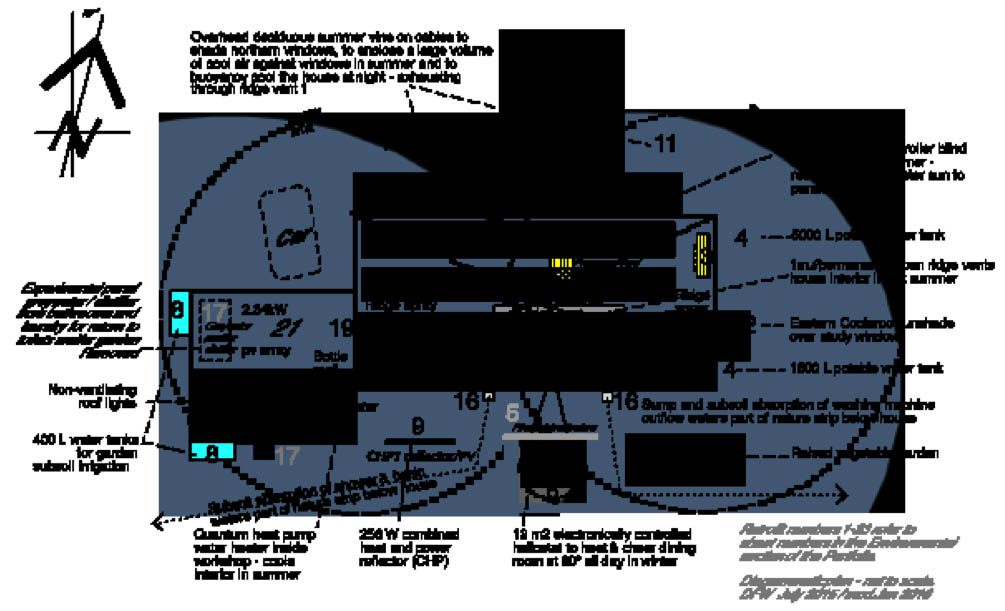This plan (also shown in the Environment segment) was started in 1991 shortly after we moved in – only being finally abandoned because of advancing age and inability to do roof work.
Our move into 2/72 Shackleton Circuit, Mawson in 1991 stimulated a new phase in my life – demonstration of the urgent need for the retrofitting of Australia’s enormous heritage of inefficient (95% of all existing stock at any one point in time) – if we are to overcome the future ravages of climate change.
I set about retrofitting the Mawson house with photovoltaic panels on the roof, designing and making my first southern reflectors and the heliostat and making and installiung my first northern sunshading system, together with making my buoyancy cooling and ventilation system – all of which changed our house into a much more useful and comfortable solar house.
In 2005 (?) the first Australian Solar House Day was initiated in the ACT by the Solar Energy Society (I was on the committee) and the Mawson house was featured with its innovative elements, drawing many comments from the viewers, such as “…why can’t we buy houses like this in the housing market ?”
In 2002 I designed similar southern reflectors for my sister Shirley in Pearce together with photovoltaic panels and a buoyancy ventilation system – also featured in subsequent Solar House Days. There are now about 10 houses with southern reflectors around the ACT and as far north as Goulburn and Blackheath in the Blue Mountains – now known as WinterSun reflectors.
Solar House Day is now observed as Sustainable House Day around Australia and is serving to arouse the community to an awareness of the need for better housing design to reduce global CO2 pollution from the burning of fossil fuels and the urgent need for reliance on renewable energies – on this day in 2016 as I type the CO2 pollution reached 400ppm.
THE FUTURE OF DESIGN
Having spent 71 years as a qualified architect, largely in the 20th century I have witnessed some significant changes in the way designers (a better collective noun) have interacted with society. This started with the more general recognition of the term ‘industrial design’ just after the second world war which gave us new materials and new techniques, stimulating new thinking about old problems. Shortages of materials after the war also caused lateral thinking about alternative ways of using new materials which by-passed conservatism and blinkered attitudes.
It was an exciting century with new horizons and new freedoms, forming a heady cocktail of perhaps too many alternatives from which we had to learn to select wisely before throwing old ways into the rubbish bin. New alloys, laminated timbers, plastics and electronics had been generated by a grossly extravagant war – all of which was a rich diet for an under-nourished and almost invisible but latent design profession.
The commercial arrival of television around 1956 in Australia, desktop computers around the 1980s, the growth of an increasingly aware media and the rapid acceptance of mobile telephones – all based on electronics – have changed society, its attitudes and habits. 1
We, as designers have become agents of change and we have flourished and expanded beyond our most optimistic expectations. Society took some time to appreciate and accept the thinking of a new multi-headed profession which questioned everything. Traditions died hard but new opportunities arose from new perceptions by designers who had the power to create many opportunities from better design.
But design can cut both ways. It can be a powerful double-edged sword if not used with discretion. The recognition of design by society has in part been unknowingly changed by a voracious and unrestrained media seeking novelty, massaging the ego of some designers with the language of superlatives. This has stimulated over-consumption and waste in a western world that has apparently not learned when ‘enough is enough’.
This is quite evident in the upper ranges of domestic architecture where many stylistic and egotistic excesses abound. This has aroused the criticism that the extravagance was a means of getting the house featured in the magazines rather than to unobtrusively improve the desirable functioning of the house to achieve health and happiness for the occupants. The egotistical drive to seek novelty and be different is very strong in an increasingly competitive world.
Such a stylistic direction can be seen as negating the ‘sustainable’ ethos we, as responsible designers, should be taking in this new world of anthropogenic global warming. This should be demanding our urgent attention and there are some encouraging signs.
Regrettably, large egos and equally large and/or pretentious houses abound in wealthy countries, and statistics indicate that Australia is the world leader in this race – not an enviable record.
It concerns me that this display of extravagance depletes our resources in many ways and is usually at the expense of our grandchildren. It is intergenerational inequity caused by sheer greed, and displays of conspicuous wealth – and design is heavily involved – even encouraged by it.
Designers of all kinds might well heed Mies van der Rohe’s famous statement that “less is more” otherwise I feel that ‘design’ might well become a dirty word if we do not caution our designers – and their clients.
Shouldn’t we, as designers, adopt the Hippocratic oath of ‘doing no harm’? It will require some concerted effort and internal discipline to tame our collective ego and instil some sense of intergenerational responsibility. It is a huge educational challenge, but do we recognise the need?
1 Friedmann’s book “The world is flat” deals in great detail how the world has, and is still, changing due to the internet and similar
factors and future changes are seen to be even more dramatic.


